
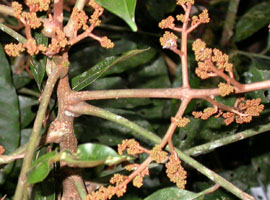

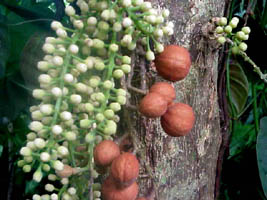
| terminal at end of branchlets(axes) | axillary arising from between a leaf and a branchlet (axis) |  |
 |
| leaf-opposed arising opposite a leaf, not between a leaf and a branchlet (axis), this character state includes inflorescences that are laterally on branches behind (below) a leaf | on the trunk or branches (cauliflorous or ramiflorous), no distinction is made between cauliflorous and ramiflorous because species which have flowers arising directly from the trunk (cauliflorous) often also have at least some flowers arising directly from the branches (ramiflorous) |
 |
 |
| flowers single (solitary), only one flower present in each inflorescence |
more than one flower present in each inflorescence which arises from either the branch, stem or trunk of the tree |
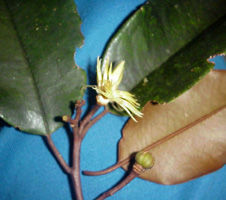 |
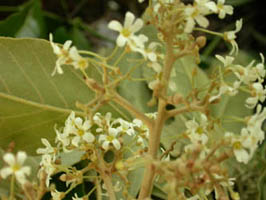 |
| flowers on an unbranched axis | flowers on a branched axis |
 |
 |
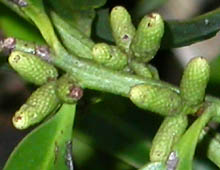
|
The flowers of Conifers are arranged in flowering strobili (strobilus, singular) often generally referred to as ‘cones’. This character generally record the absence (dicotyledonous plants) or presence (Conifers) of strobili, However, the Podocarpaceae (as illustrated here) is a dicotyledon which has female flowers arranged in strobili. This feature is recorded , as either: |
| unisexual with flowers either male or female |
bisexual with both androecium (stamens) and gynoecium (ovary, with or without style, with stigma) |
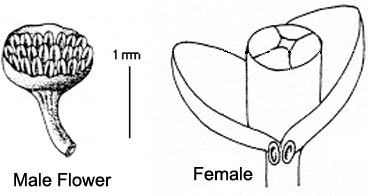 |
 |
| When the flowers are unisexual, this character records whether these flowers occur on the same plant (hence, plant monoecious) or male occur on one plant and the female flowers occur on a separate plant (hence, plant dioecious). Therefore, the plants are recorded as either: |
| not stalked(sessile) | stalked(pedicellate) |
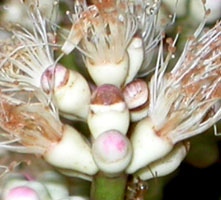 |
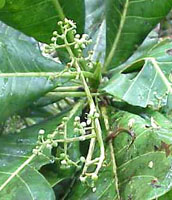 |
| The shape of flowers varies considerably between species and this variation is often reflected in the number of planes of symmetry within the flower. Architecturally, they may be regular, with many planes of symmetry to very irregular. The symmetry of flowers is described as: |
| with many planes of symmetry (actinomorphic) | slightly asymmetric with one plane of symmetry (zygomorphic) | completely asymmetric |
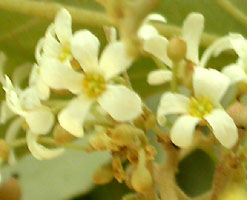 |
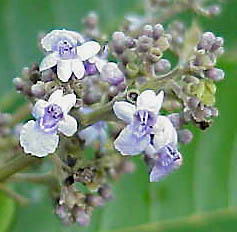 |
 |
| The length of the flower is measured in millimetres (mm) from the base of the perianth (from the distal end of the pedicel (stalk) if flower pedicellate) to the end of the perianth (sepals and/or petals). Note: often the style and stigma are distinctly exerted far beyond the perianth. These features are not included in this measurement. |
|
The diameter of the flower is classified according to: small (< or =10 mm diam.), or large (>10 mm diam.) |
|
The absence or presence of a perianth in the flowers is recorded as either: absent, or present |
| Note: this feature is not concerned about the number of distinct whorls of perianth. There may be both sepals and petals present or just one of these whorls. |
| with distinct speals and petals | whorls integrating from sepals to petals | with all sepals and/or petals (hence tepals) similar |
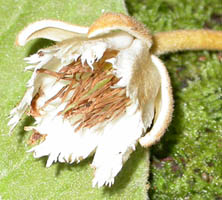 |
 |

|
|
The colour of the perianth which is closest to the stamens and/or ovary, usually regarded as the corolla (petals), or if only one perianth whorl, then this character refers to the colour of that whorl, which is recorded as: |
|
white yellow orange pink red blue purple mauve green brown grey cream-coloured |
| Note: often several colours are present. The inner perianth may consist of more than one colour and these colours should be recorded. However, the various hue/shades of colour are not recorded, but rather the basic colour types list above should only be used. |
| The number of parts of the inner perianth, whether free (not joined) or variously joined to each other. The value ‘100’ is arbitrarily assigned when there are many perianth parts. |
|
The extent of fusion/joining of the parts of the inner perianth (usually the corolla or petals) or the only perianth whorl to the other parts of the whorl. This is recorded as: |
| free - when all the parts of the perianth are not united to each other | some or partly joined - when at least some parts of the perianth are joined together | all joined - all of the parts of the perianth are joined together such that there is a corolla tube with corolla lobes absent or greatly reduced and so not obvious |
 |
 |
 |
| The number of stamens, whether free (not joined) or variously joined to each other. |
| The value ‘100’ is arbitrarily assigned when there are many stamens | 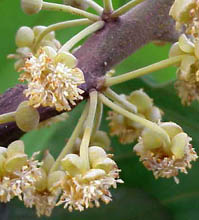 |
| absent | present |
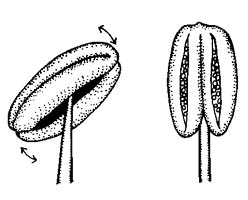 |
| free from each other | joined (connate), at least in part |
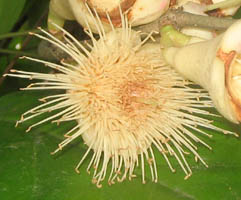 |
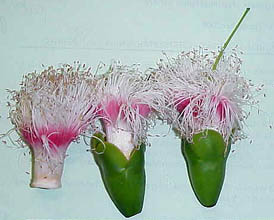 |
| free of the perianth stamens not joined to the perianth |
joined to the perianth (epipetalous/episepalous) |
|
This feature records the position of the ovary with respect to the point of insertion of the petals and/or sepals. The ovary is recorded as: |
| superior - ovary seated above petals and sepals (hypogenous) | partly inferior (perigenous) | inferior - ovary seated below petals and sepals (epigenous) | 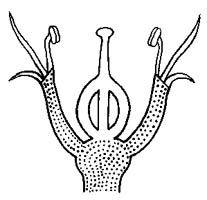 |
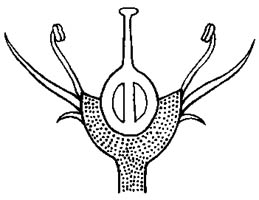 |
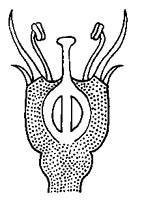 |
| solitary (monomerous) - the ovary consisting of a single carpel | 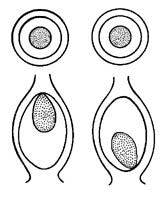 |
| separate (when more than one - apocarpous), each carpel completely free from the other carpels | joined (when more than one carpel - syncarpous), all carpels completely joined together |
 |
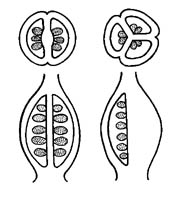
|
| partially joined, by base - the distal parts of the carpels are free from each other, not united, and the styles are also separate | partially joined by styles - the basal parts of the carpels are free from each other, not united, but are joined together by their styles |
 |

|
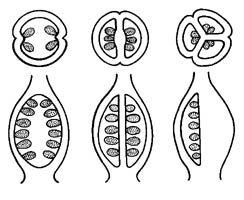
|
The number of locules (chambers that contain the ovules) of the gynoecium (The illustration shows 1, 2 and 3 locules, respectively) |
|
The gynoecium consists of an ovary and one or more stigmas. The stigma(s) are inserted on the end of a style or the style is absent. This feature records the absence or presence of one or more styles. The style is recorded as: |
| absent | solitary (including joined together) |
free (more than one style, entirely free from each other) |
 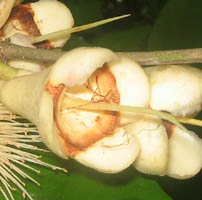 |
The infructescence is described as consisting of either:
| fruits single (solitary), only one flower present in each infructescence |
fruits arising from a single point but with more than one fruit present in each infructescence, which arises from either the branch, stem or trunk of the tree |
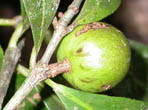 |
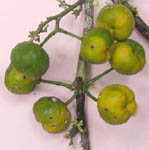 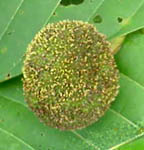 |
| fruits on an unbranched axis | fruits on a branched axis |
 |
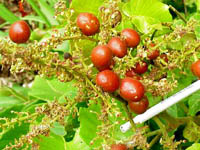 |
|
white cream-coloured yellow green blue orange red brown grey black purple |
| This feature records the absence or presence of spines on the surface of the fruit (in dicotyledons) as either: |

|
not spiny, or spiny |
| non-fleshy | fleshy |
 |
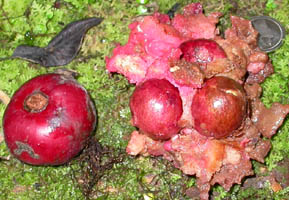 |
| simple - a fruit which is derived from a single flower flower that has a single carpel or several fused carpels | aggregrate - a fruit that has developed from several separate carpels of one flower |
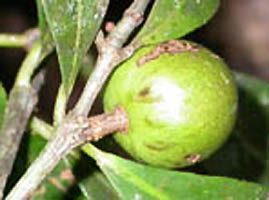 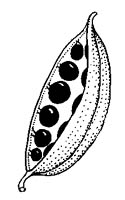 |
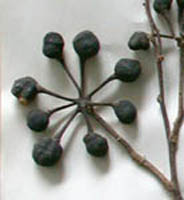 |
| multiple (excluding figs) - a fruit which is consists of the carpels from several flowers in an inflorescence/infrutescence | syconium (fig) - the 'fig' is a specific example of a multiple fruit where the individual achenes (dry, one-seeded, indehiscent fruits) are borne on the inside of a hollowed-out receptacle or peduncle |
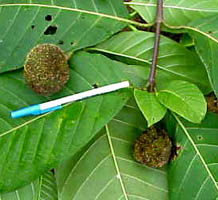 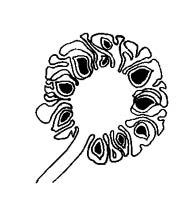 |
 |
|
The mature fruits of dicotyledons open in a set way (dehiscent) to release their seeds or they do not open on maturity (indehiscent). Therefore, the fruits are recorded as: |
| indehiscent | dehiscent |
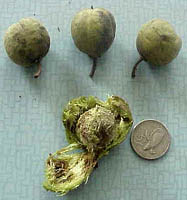 |
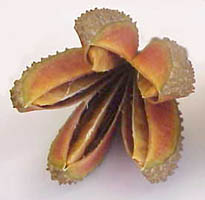 |
| capsule - a simple, dry fruit that opens in a definite way, consisting of two or more carpels | follicle - a simple, dry, dehiscent fruit with one carpel that opens along one side of the fruit |

| 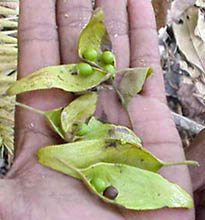
|
| legume - a simple, dry, dehiscent fruit with one carpel that opens along two sides of the fruit | loment - a special type of legume that separates transversely between seed sections |
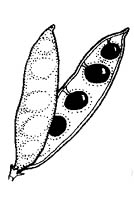 |
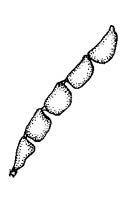
|
| achene - a simple, dry, one-seeded, indehiscent fruit that has developed from a flower with a superior ovary | berry - a simple, indehiscent, more or less juicy/fleshy, few- to many-seeded fruit, with a fleshy fruit wall (pericarp) |

|

|
drupe - a simple, indehiscent, more or less fleshy fruit that is derived from a single carpel, usually one-seeded, in which the exocarp (outermost part of pericarp) is thin, the mesocarp (middle layer of pericarp) is fleshy, and the endocarp (innermost layer of pericarp) is stony | hesperidium - a special type of berry that has a thick shin, is septate, and with the bulk of the fruit derived from glandular hairs |

|
 |
| nut - a simple, dry, indehiscent, one-seeded fruit with a hard fruit wall (pericarp), usually derived from a one-loculed ovary, as in the Rutaceae | pepo - a special type of berry that has a leathery, non-septate rind (pericarp) derived from a flower with an inferior ovary |
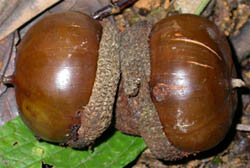
|  |
pome - a simple, indehiscent, fleshy fruit, the outer part of which is formed by the floral parts that surround the ovary. This special type of simple fruit is often referred to as an Accessory fruit | samara - a simple, dry, indehiscent, one- or two-seeded fruit with the pericarp bearing a wing-like outgrowth |
 |
|
| schizocarp - a fruit with two or more united carpels that split apart at maturity | syconium - sometimes the 'fig' is incorrectly referred to as if it were a simple fruit rather than a special type of multiple fruit. The individual fruits within the fig are achenes. |
 |
 |
| The seeds of Conifers are arranged in usually woody fruiting strobili (strobilus, singular), referred to a cones. |
| This character records the absence (dicotyledonous plants) or presence (conifers) of cones (strobili), as either: absent, or present |
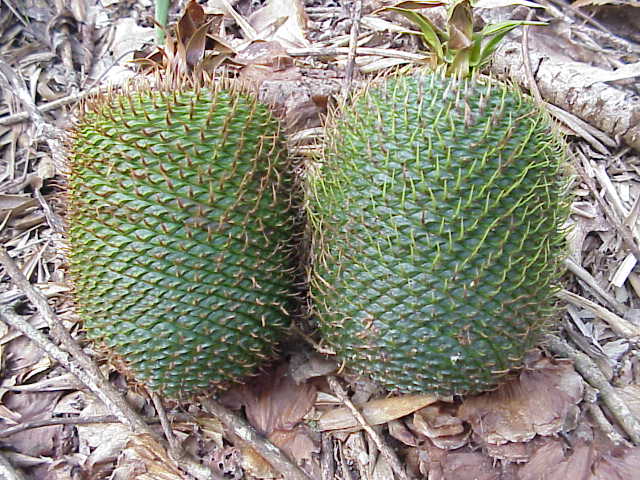
|
| When the plant is a conifer, the diameter at the widest part of the mature cone, measured in millimetres (mm) |
|
green brown |
| The number of seeds produced by each fruit is recorded. The value ‘100’ is arbitrarily assigned when there are many seeds |
|
This feature records the presence or absence of one or more wing appendage on the surface of the seed. |
| not winged | winged |
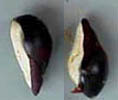 |
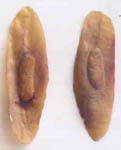 |
| irregular | broad (as wide as long) | narrow (longer than wide) |
 |
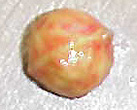 |
 |
| This feature records the maximum diameter or width of the flattened seeds, in millimetres (mm). When one or more wings are present, these are excluded from the measurement of the seed. |
| The seed size is categorised as: < 1 mm diam. - less than 1 mm diameter 1-10 mm diam. >10 mm diam. - greater than 10 mm diameter |
| Note: the range of values for the diameter (mm) of seeds for some species has also been provided |